Canon Powershot A40
only £149.99
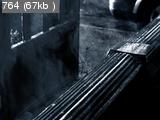 …said the advert in the window of my local branch of Jacobs. Heck, that sounds like a good price, I thought. Pity I didn’t want a digital camera. Actually, it’s a real shame. Later, I checked out the spec and typical A40 prices on the Internet; 2MP, last year’s model, due for replacement but still reasonably new, good reports. Yep, it’s almost a crime that I don’t want one at that price. Because I can’t justify it. At all. Not another camera. Oh no.
…said the advert in the window of my local branch of Jacobs. Heck, that sounds like a good price, I thought. Pity I didn’t want a digital camera. Actually, it’s a real shame. Later, I checked out the spec and typical A40 prices on the Internet; 2MP, last year’s model, due for replacement but still reasonably new, good reports. Yep, it’s almost a crime that I don’t want one at that price. Because I can’t justify it. At all. Not another camera. Oh no.
Although, I guess you could use it for refining your shooting technique, trying out compositions and experimenting with new shots which would be Very Important for any Aspiring Amateur Photographer. And of course, my Glamorous Research Assistant and I were planning to start a family this year, and I supposed a digicam would be handy if you wanted to email photos of your baby to distant relatives (unless none of them own a computer, but we’ll skate over that minor issue).
I ran this excuse inarguable logic past the GRA and she agreed. (Thinks: now, is there a reason why new parents might also need an Apple Mac?) And that was how I found myself buying an Canon A40 at a bargain price. (A month later, Amazon was offering the A60, which had superseded the A40 and was now itself discontinued, for £99.)
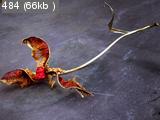 To date, I’ve shot approximately 900 frames with it. That’s not many, especially compared to the average photoblogger, but then I feel that this camera only has a few niche applications for my purposes. And one of those is not proofing 35mm shots (so-called “digital polaroids”) . There is almost no confluence between an SLR with a fast 50mm lens loaded with B&W film, and a digicam with a small sensor and a zoom lens. The aesthetics are completely different. The wonderful isolation and bokeh that the 50mm lens provides is impossible to reproduce with the digital, and post-processing to monochrome later, or even in-camera, doesn’t have the same tonal response, grain and appeal of HP5. The digital is also useless handheld in the kind of low light that makes B&W look great. I find the conceptual translation required between them too great a mental leap. The digicam cannot perform for the kind of work I normally pursue.
To date, I’ve shot approximately 900 frames with it. That’s not many, especially compared to the average photoblogger, but then I feel that this camera only has a few niche applications for my purposes. And one of those is not proofing 35mm shots (so-called “digital polaroids”) . There is almost no confluence between an SLR with a fast 50mm lens loaded with B&W film, and a digicam with a small sensor and a zoom lens. The aesthetics are completely different. The wonderful isolation and bokeh that the 50mm lens provides is impossible to reproduce with the digital, and post-processing to monochrome later, or even in-camera, doesn’t have the same tonal response, grain and appeal of HP5. The digital is also useless handheld in the kind of low light that makes B&W look great. I find the conceptual translation required between them too great a mental leap. The digicam cannot perform for the kind of work I normally pursue.
So it doesn’t do that; what does it do? For a casual walkabout camera, it’s extremely convenient. I never used to take a camera everywhere I went; the extra bulk and attention an SLR draws, alongside the fact that I never seemed to spot the opportunities to use it, made it a disappointing, demotivating experience that I quickly gave up. And, as discussed, I just couldn’t “do” compacts. But the A40 combines small size with some of the controllability of a larger camera, coupled with zero cost of materials. I’ll pull out the A40 in circumstances where I simply wouldn’t have bothered with another camera, even when it takes a second or two to switch on. (The latter is a consideration; you’ll wait forever while the A40 retracts the lens cover, extends the zoom and activates the display.)
 It has a full, but limited manual mode, which is to say that you have complete control over aperture and shutter speed but the options are still fairly restricted. There is a choice of two(!) apertures: wide or narrow, and good luck telling the difference in terms of the effect on depth of field. Shutter speed choices are better, anything down to 15 seconds. Unfortunately, there is no exposure display other than simply taking the shot and seeing how it comes out, then repeating if necessary and possible. Focusing cannot be adjusted, although you can limit the autofocus range to one of three zones (close-up, portrait or distance - almost like the old Olympus Trip 35). ISO is variable across 50 to 400. Most of the time, I leave this in Auto mode, which sounded like an acceptable compromise until I read the manual and discovered that it only selects from ISO 50 to 150 (and seems to be biased to slower speeds); this explained why so many of my shots were coming out with motion blur or camera shake. ISO 400 will often prove too noisy, but 200 gives acceptable quality for indoor use.
It has a full, but limited manual mode, which is to say that you have complete control over aperture and shutter speed but the options are still fairly restricted. There is a choice of two(!) apertures: wide or narrow, and good luck telling the difference in terms of the effect on depth of field. Shutter speed choices are better, anything down to 15 seconds. Unfortunately, there is no exposure display other than simply taking the shot and seeing how it comes out, then repeating if necessary and possible. Focusing cannot be adjusted, although you can limit the autofocus range to one of three zones (close-up, portrait or distance - almost like the old Olympus Trip 35). ISO is variable across 50 to 400. Most of the time, I leave this in Auto mode, which sounded like an acceptable compromise until I read the manual and discovered that it only selects from ISO 50 to 150 (and seems to be biased to slower speeds); this explained why so many of my shots were coming out with motion blur or camera shake. ISO 400 will often prove too noisy, but 200 gives acceptable quality for indoor use.
Despite the problems in low light with slow ISOs, you can handhold a digicam at much slower shutter speeds than an SLR. It’s smaller, there are no moving parts and you can make several attempts. That said, the standard digicam position - arms outstretched, studying the LCD like you’re admiring the camera instead of the scene - is probably the worst one could choose for ensuring steadiness. There is, of course, also a viewfinder - and the viewfinder is CRAP. It has an 80% view with severe parallax offset at medium to short distance (indeed, the manual warns you not to use it for “macro” shots). Thus, you have a choice between using the LCD and possibly not getting the shot due to shakiness or the viewfinder and not getting it due to completely different framing from what you intended; most of the time, one settles for the convenience of the LCD and hopes for the best.
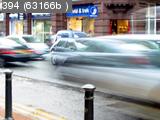 Fortunately, hope is often rewarded. In manual mode, with some experimentation before settling on f/2.8 and 1/6th sec, I managed to shoot some decent traffic trails, including a great shot of a sports car accelerating away from a junction with its surroundings remaining pin-sharp - handheld. That was the first time I realised that you could get some great photos with a digicam. For example, try setting a slow shutter speed and then pressing the button as you walk along or simply waving it around randomly.
Fortunately, hope is often rewarded. In manual mode, with some experimentation before settling on f/2.8 and 1/6th sec, I managed to shoot some decent traffic trails, including a great shot of a sports car accelerating away from a junction with its surroundings remaining pin-sharp - handheld. That was the first time I realised that you could get some great photos with a digicam. For example, try setting a slow shutter speed and then pressing the button as you walk along or simply waving it around randomly.
The A40 has two other significant modes, Automatic and Programmable. Automatic is auto-everything; suitable for quick snaps, naïve users or people to whom you’ve lent the camera when you want to be in the frame yourself. Programmable lets you refine the automated selections, giving you control over flash mode, ISO, focus range, etc. A really nice feature: menu settings are unique to each mode and are stored across mode changes, so you can set small, low quality JPEG output for Automatic snapshots and large, best quality JPEGs with no in-camera sharpening for your artistic masterpieces in Programmable mode. I shoot most of my pictures in Programmable mode, varying the flash setting as required. However, I stopped disabling in-camera sharpening because I found it acceptable and it meant I could skip post-processing if it wasn’t necessary or I didn’t want to bother.
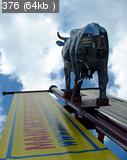 A digicam’s other main niche is in taking good quality holiday snapshots economically. We took the A40 on vacation to Barcelona and Jersey as our sole colour camera, burnt fifty good shots to CD and had some excellent prints back within 24 hours for a fiver. The CD became the “negatives”, the prints could all go straight into an album and the empty envelope could be thrown away (I say “could” because these last two steps are yet to occur). We even shot a brief movie (with audio) of the Font Magica at the foot of Montjuic, by using a bendy pocket tripod.
A digicam’s other main niche is in taking good quality holiday snapshots economically. We took the A40 on vacation to Barcelona and Jersey as our sole colour camera, burnt fifty good shots to CD and had some excellent prints back within 24 hours for a fiver. The CD became the “negatives”, the prints could all go straight into an album and the empty envelope could be thrown away (I say “could” because these last two steps are yet to occur). We even shot a brief movie (with audio) of the Font Magica at the foot of Montjuic, by using a bendy pocket tripod.
Despite my disappointment with the digicam when compared to my classic SLR and 50mm combination, I found that I could shoot a few frames if I simply wandered around with it. If the shot doesn’t work - fine, delete it and try something else. No wasted frame to highlight your incompetence later when you get the roll developed. The shots once in the computer are nice and clean with no grain (you could add some, but then again a little Rodinal goes a long way…). With two megapixels, a full size shot is 1600 x 1200 pixels. At the normally recommended 300 dpi, that will produce a 5x4” print. However, you can easily push the resolution to 200 or even 150 dpi to produce an acceptable, if not optimal, 10x8” print because there’s no ugly grain, dust or other debris to blow up as well, and you can sharpen the image to a higher degree for the same reason. (On the other hand, if you’re too lazy to do any manipulation, I found that plugging the CF card straight into my HP Photosmart 7660 gave me perfectly good standard size prints.)
 The A40 is now ancient history; Canon’s current line-up is the A85/95, the S70 or the G6 for “advanced” users (at time of writing, 5pm; expect a couple of these to be replaced by 7pm). What do you get from the later models?
The A40 is now ancient history; Canon’s current line-up is the A85/95, the S70 or the G6 for “advanced” users (at time of writing, 5pm; expect a couple of these to be replaced by 7pm). What do you get from the later models?
- More pixels. I don’t feel the need for larger prints, and most users never go beyond 7x5” prints, but it gives you deeper cropping options because you can afford to lose more data.
- Better manual control. Precise focusing, more settings and a better interface.
- Flip-out (“vari-angle”) LCDs. Angle the LCD upwards or forwards to make certain shots easier to judge.
- More shooting modes. Aargh, more choices?? It looks great on the spec sheet (“Beach/Night/Fireworks/Wedding/Auntie Bertha Extreme Wide Angle!”), but these are usually a palliative for thinking about the shot. Aperture and shutter priority are available, for what they’re worth.
Custom modes on the G6 might be more useful. - HIstogram display, so you have a more scientific way of checking exposure.
- More autofocus points. Well OK. I wasn’t really feeling the pain of those six missing points though.
- Finer White balance control. The A40 hides this under the guise of sunny/cloudy/flourescent/etc lighting modes. Inevitably, you’ll find yourself in a situation where none of the options quite match and you’ll wish you could simply tell it what “white” is.
- RAW image formats (S-range and above). It’s difficult to do “serious” work with JPEG output, and any extensive manipulation is out.
- Smarter algorithms. Comforting but again, you should be doing the work yourself rather than relying on the camera.
- Better close-up focusing. Calling the A40’s close-up mode “macro” would be a little disingenuous at around 30cm minimum distance. 5cm is more like it.
- Faster lens on the G6 (f/2). Better for low light work, but that tiny sensor will always kill that DOF isolation capability.
- Less shutter lag. Well, maybe - newer technology, right? But user reports still aren’t overwhelming in this respect.
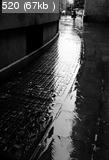 Of these, I’d say the greater resolution, manual control, RAW format, and perhaps vari-angle LCD would be the most attractive extras to me. On the other hand, the higher price and larger files currently outweigh these considerations (at least until Junior grows up, heheheh - but by then, DSLRs might be a more viable option).
Of these, I’d say the greater resolution, manual control, RAW format, and perhaps vari-angle LCD would be the most attractive extras to me. On the other hand, the higher price and larger files currently outweigh these considerations (at least until Junior grows up, heheheh - but by then, DSLRs might be a more viable option).
Postscript
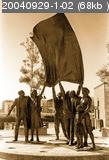 Standing before the Liberation memorial in St Helier, I raised my faithful EM with the 50/1.8 E lens and ever-present orange filter to my eye. It had been several months since I’d used the Nikon, owing to lack of opportunities and a period spent exploring the possibilities of the A40. As I turned the focus ring, various elements within the viewfinder swam smoothly into and out of focus, sharpened against an attractive fore- and background blurring. The filter drained the colour from the scene, giving me an idea of how it would look when I saw the developed HP5 frame. Right now, it looked wonderful.
Standing before the Liberation memorial in St Helier, I raised my faithful EM with the 50/1.8 E lens and ever-present orange filter to my eye. It had been several months since I’d used the Nikon, owing to lack of opportunities and a period spent exploring the possibilities of the A40. As I turned the focus ring, various elements within the viewfinder swam smoothly into and out of focus, sharpened against an attractive fore- and background blurring. The filter drained the colour from the scene, giving me an idea of how it would look when I saw the developed HP5 frame. Right now, it looked wonderful.
…As well-designed and clever as the A40 is, this to me was proper photography.
Other bubbles
- Digital ain’t black and white part 1
- photo.net has a good comparison table of the later Canon models.
